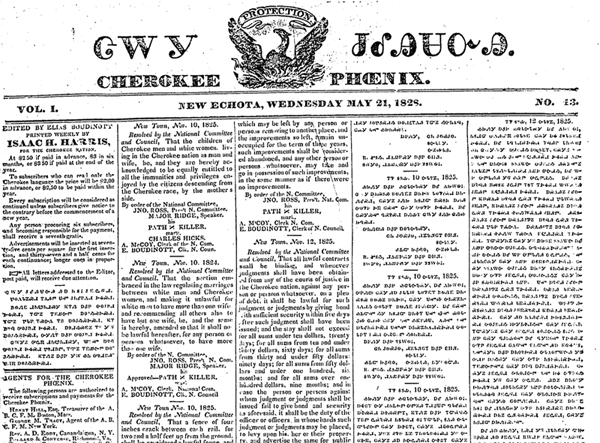With the acceptance of his syllabary as the official written form of the Cherokee language, Sequoyah was in the ascendancy. Even some of his more traditional critics began to realize the power of having a written language. Scorn turned to praise almost overnight as Sequoyah traveled throughout the constituent communities of Cherokee Nation and continued to spread his new invention. This was done without the creation of schools or formal institutions of learning. As Sequoyah traveled, he trained small groups of Cherokee in the new syllabary. These pupils soon became teachers—using their knowledge to train others in the use of the syllabary. Literacy rates within the Cherokee Nation soared to new heights—even surpassing those of the surrounding white communities. The Cherokee Nation was now officially bi-lingual; able to read and write in two languages.
A Cultural Revival
In New Echota, the capital city and seat of the National Council of the Cherokee Nation, government leaders envisioned myriad uses for Sequoyah’s syllabary. For his efforts, Sequoyah was awarded a medal by the National Council in 1824. Struck in pure silver, the medal bore an inscription praising Sequoyah “for his ingenuity in the invention of the Cherokee Alphabet.” Beneath the inscription were two crossed tobacco pipes. Principal Chief John Ross saw the syllabary as an opportunity to institute a cultural revival for the Cherokee Nation. Joining him in the endeavor were other influential leaders such as Major Ridge. Schools, museums, a Cherokee language newspaper, and even a written constitution were envisioned. With the support of the Cherokee government, all of these wonders were achieved.
Di-tsa-la-gis in Action
In 1828, the Cherokee syllabary was cast into movable typeface and used to create the first mass publication in a native tongue—the Cherokee Phoenix. Missionary Samuel Worcester, himself and silversmith and printer, is believed to be the man responsible for casting the movable typeface for this publication. While Worcester tried to remain faithful to the characters originally developed by Sequoyah, this proved difficult due to the sheer elegance of the inventor’s script. Worcester did borrow from Greek and Latin characters to stand in for a few of the characters, but the finished template by and large resembled the original. The first issue of the Cherokee Phoenix rolled off the presses on February 21, 1828. Elias Boudinot served as the first editor of the publication.
Sequoyah in the West
As early as 1812, some Cherokee families had started a westward migration in an effort to settle new territories away from white incursions. Originally settling in Arkansas, these groups later moved to Oklahoma. Sequoyah was aware that the Cherokee Nation would not be able to remain in the east indefinitely—the rapid encroachment of white communities on Cherokee domain proved a clear indication of future events. Seeking to spread knowledge of his syllabary among these migrants, Sequoyah himself proceeded westward in 1825. Originally settling in Arkansas, he continued to serve the Cherokee people for the remainder of his life—returning to his roots as a silversmith. Despite seeking a quiet retirement, Sequoyah was often called upon to mediate disputes between communities in the west. In 1828, he traveled to Washington D.C. in an effort to negotiate a treaty securing land rights for the Cherokee Nation in Indian Territory. In the year following the Trail of Tears, his counsel was once again sought to resolve disputes between the western Cherokee and the newly arrived easterners.
Sources:
- Mark C. Carnes, Ed., U.S. History. (New York: Macmillan Library Reference, 1996).
- John Ehle. Trail of Tears: The Rise and Fall of the Cherokee Nation. (New York: Anchor Books, 1989).
- Michael Garrett. Walking on the Wind. (Rochester:Bear and Company Publishing, 1998).
- Ruth Bradley Holmes and Betty Sharp Smith. Beginning Cherokee. (Norman; University of Oklahoma Press, 1977).
- David M Jones and Brian L Molyneaux. Mythology of the American Nations. (London: Anness Publishing, 2006).
- Peter Matthiessen, Ed., George Catlin: North American Indians. (New York: Penguin Books, 1989).
- James M. McPherson. “To the Best of My Ability: The American Presidents. (London: Dorling Kindersley, 2000).
- Marilyn Miller, Ed., The American History Desk Reference. (New York: MacMillan, 1997).
- Carl Waldman, The North American Indian. (New York: Checkmark Books, 2000.)
- Carl Waldman, Encyclopedia of Native American Tribes. (New York: Checkmark Books, 2006).







